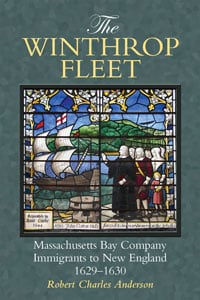 The activities of the Massachusetts Bay Company in 1629-30 were uniformly organized from the top down. The Company either purchased or hired the vessels to carry the passengers and provisions. The passengers themselves, and especially the critically important professionals such as ministers and soldiers, were recruited by the Company leaders.
The activities of the Massachusetts Bay Company in 1629-30 were uniformly organized from the top down. The Company either purchased or hired the vessels to carry the passengers and provisions. The passengers themselves, and especially the critically important professionals such as ministers and soldiers, were recruited by the Company leaders.
Yet this phase of the migration was brief, as most of the merchants involved found the enterprises for which all this activity was expended to be losing propositions and allowed their New England plantations to disperse, some almost immediately and most by the middle of the next decade. The influence of those leaders of the Massachusetts Bay Company who remained behind in England quickly faded away, and by 1632 the top-down direction of the migration process was essentially at an end.
The Laudian Migration – a reaction to the threatening overtures of the new Archbishop of Canterbury – did not feature Gentlemen’s Companies or Merchant’s Companies. No corporate office in London organized and provided for these emigrants. There were fewer companies of allied but unrelated travelers; instead, migrating families generally made their way to the London docks, or less frequently to the docks at one or another of the outports, and signed on for passage in vessels designated for that purpose by their owners, who were not otherwise devoted to the colonization process. These passengers had to provide or purchase their own provisions for the passage and for their own use once on the ground in Massachusetts Bay.
In contrast with the Winthrop Migration, the Laudian Migration was directed from the bottom up, the migrants organizing themselves around those Puritan ministers who chose to make the move to New England. In the typical sequence, a few families might precede the minister across the Atlantic, followed by the minister along with several more families, and then succeeded by a few more families who had been attracted to the group.
It might fairly be said that the migrations of the 1620s – amounting to about twenty percent of the Great Migration total – was characterized by top-down operations, from the efforts of Sir Ferdinando Gorges and others to induce West Country fishermen to move their operations across the Atlantic, to the Leiden Pilgrims and the Dorchester and Massachusetts Bay Companies, all to some extent managed by wealthy merchants who organized passage for their followers. All of these speculations ran their course in the period between 1620 and about 1632.
The remainder of the Great Migration consisted of the Laudian Migration, the only element of the migration organized on a bottom-up, spontaneous principle. There were fifteen or sixteen thousand immigrants in this group, mostly arriving between 1633 and 1640, after which events in England reduced the pace of travel to a trickle, signaling the end of the Great Migration.
Adapted from the introduction to The Winthrop Fleet.
Share this:

About Robert Charles Anderson
Robert Charles Anderson, Director of the Great Migration Study Project, was educated as a biochemist and served in the United States Army in electronics intelligence. In 1972 he discovered his early New England ancestry and thereafter devoted his time and energies to genealogical research. He published his first genealogical article in 1976, and about the same time began to plan for what eventually became the Great Migration Study Project. In 1983 he received a Master’s degree in colonial American History from the University of Massachusetts at Amherst. Anderson was elected a Fellow of the American Society of Genealogists in 1978 and has served as Secretary and President of that organization. He became a Contributing Editor of The American Genealogist in 1979, Associate Editor in 1985 and Coeditor in 1993. He has been an editorial consultant to the New England Historical and Genealogical Register since 1989.View all posts by Robert Charles Anderson →